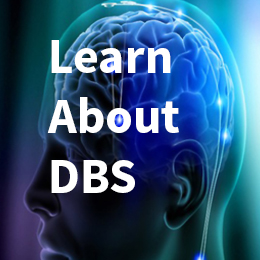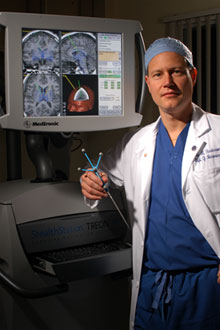Research in Stanford’s Functional Neurosurgery Program focuses on a variety of treatments for movement-related disorders, pain, and epilepsy. Many of the therapies available through the Program utilize the stereotactic neurosurgical techniques developed at Stanford.
Functional Neurosurgery staff collaborate with scientists in the Neuro-Muscular Clinic within the Department of Neurology and Neurological Sciences, Stanford's Pain Program, the Epilepsy Program and Biomotion Research Group.


Jaimie M. Henderson, M.D.
Deep Brain Stimulation (DBS) for Movement Disorders and Pain Control
Dr. Henderson is among a handful of West Coast neurosurgeons performing DBS implantation and monitoring to treat movement disorders and chronic pain. The implantable pulse generator is a thin insulated wire with four microelectrodes at its tip. It is implanted in brain areas that are known to be involved in the patient's disease, such as the globus pallidus or subthalamic nucleus in Parkinson's patients. The surgeon positions the DBS electrode with submillimeter accuracy using state-of-the-art surgical navigation technology. After recovery the brain area is stimulated through a small device similar to a cardiac pacemaker that is implanted under the skin of the chest. The stimulation parameters can be adjusted across a wide range to maximize the relief of pain or disordered movements. In Parkinson's disease we currently achieve an 85% reduction in symptoms with a 50-60% reduction in medication.
Specialties
- Hemifacial spasm
Hemifacial spasm is a disorder characterized by sudden and uncontrolled movements of the face. Hemifacial spasm may be treated both noninvasively and invasively. Noninvasive therapies for hemifacial spasm include oral baclofen, local injections of botulinum toxin and other central-acting medications. Hemifacial spasms are often attributed to a blood vessel compressing the nerve (cranial nerve seven) that supplies the facial musculature as it exits the brain stem. The so-called microvascular decompression of the seventh nerve is a reliable and efficacious way of treating hemifacial spasms. Upwards of %70 percent of the patients develop long term relief form the procedure. However, as with all forms of surgery, there are risks; for the procedure they are about 3%. These risks include damage to the surrounding auditory nerve, resulting in partial or permanent loss of hearing on that side, and damage to the vestibular nerve, which may lead to a sense of dizziness, nausea and an unsteady gait. Despite these complications, microvascular decompression of the seventh nerve still remains the procedure of choice for definitive therapy of hemifacial spasm.
- Dystonia
Idiopathic and generalized dystonias are poorly understood disorders. They are characterized by uncontrolled writhing of a limb and/or the entire body. One dystonia has now had its genetic basis understood and, in fact, the so-called DYT-1 gene has a commercial assay available. Therefore, patients with general dystonia can determine if they are DYT-1 positive. This may have significance for family planning and counseling of the siblings and descendants of patients with generalized dystonia. We now have an effective surgical target for generalized dystonia; the posterior ventral globus pallidus. The actual surgical intervention can consists of destroying a specific region of the globus pallidus or placement of a deep brain stimulator to functionally inactivate these same tissues. Both techniques have shown success in the treatment of dystonia. The experience of posterior ventral pallidotomy (tissue destruction), however, is greater than deep brain stimulation. Currently, the posterior ventral pallidotomy, as applied to dystonia, appears to represent a long-term and stable solution to this disfiguring disorder.
- Idiopathic dystonia
Idiopathic and generalized dystonias are poorly understood disorders. They are characterized by uncontrolled writhing of a limb and/or the entire body. One dystonia has now had its genetic basis understood and, in fact, the so-called DYT-1 gene has a commercial assay available. Therefore, patients with general dystonia can determine if they are DYT-1 positive. This may have significance for family planning and counseling of the siblings and descendants of patients with generalized dystonia. We now have an effective surgical target for generalized dystonia; the posterior ventral globus pallidus. The actual surgical intervention can consists of destroying a specific region of the globus pallidus or placement of a deep brain stimulator to functionally inactivate these same tissues. Both techniques have shown success in the treatment of dystonia. The experience of posterior ventral pallidotomy (tissue destruction), however, is greater than deep brain stimulation. Currently, the posterior ventral pallidotomy, as applied to dystonia, appears to represent a long-term and stable solution to this disfiguring disorder.
- Parkinson's disease
Idiopathic Parkinson disease, which is unresponsive to medications, or in patients who suffer from severe medical complications, may be addressed surgically. Traditionally, Parkinson disease has been addressed with two procedures involving destruction of discrete areas of the brain. VIM thalamotomy has been shown to reduce Parkinsonian tremor in a significant majority of patients; however, there are unexpected complications in the 7% to 9% ranges. Furthermore, thalamotomies performed on both sides of the brain have a vast increase in the complication rate, with some authors reporting up to 21% of the patients suffering problems with their speech to the point of being unintelligible. Recently, the Medtronics Corporation has introduced an implanted device, which mimics the effects of thalamotomy. This so-called deep brain stimulator has been shown to mimic the effects of a thalamotomy while preserving the regional functions of the neighboring brain tissue. By making adjustments on the stimulation parameter, neurologists and neurosurgeons are able to achieve the same benefits of thalamotomy (i.e. reduction in tremor), yet avoid the complications by subtle changes in the programming. Furthermore, bilateral deep brain stimulation of the thalamic region, although may produce problems with speech, can easily be overcome by turning one of the devices off. The patient retains control of the therapy in that they can turn the device on and off via a magnet placed over it. The entire system is implantable and resembles a pacemaker in its size. For further reviews of the device please see the web site, medtronic.com, under ACTIVA system.
- Spasticity
Spasticity, an abnormal stiffness of the body, can be treated in a variety of ways. Oral baclofen has been shown to provide the best noninvasive relief. Additional medications used for spasticity include Zanaflex and Flexeril; however, all of these medications eventually develop tolerance and accompanying side effects. One surgical intervention for spasticity includes an implantation of an intrathecal pump (see Medtronic.com). This device allows administration of the baclofen or other antispasmodic drugs directly to the spinal cord where they are most needed. This direct administration minimizes these overall systemic effects of the drug, while maximizing its potency at the area where it is most needed. Prior to implantation of the pump, a trial dose of baclofen can be given and the patient's response checked. Patients with a %50 or greater reduction in their spasticity are good candidates for pump implantation. The pumps need to be filled once every 3-4 months by a minor procedure. The dose rate of the medication can be adjusted with a programmer that communicates with the pump through the skin with radiowaves. An additional surgical procedure for spasticity is selective dorsal rhizotomies. In the hands of an experienced surgeon, this procedure can produce substantial relief in the spasticity of the lower extremities; however, it is often fraught with difficulty, and it is not generally recognized or used widely.
- Tremor
Tremors can present in numerous forms. Tremor can be defined functionally as postural (tremor that occurs whenever the limbs are held in a particular posture), action and action-specific (i.e., reaching for a glass of water or handwriting), or resting (when the patient's hands are quietly resting on their lap). Tremors can also be defined along formal disease categories. For example, essential tremor, rubro or rubro-cerrebellar tremor, intention tremor, and Parkinsonian tremor are all common diagnosis given to patients. All types of tremor however, respond to deep brain stimulation. The stimulator is placed in a region deep in the brain called the VIM thalamic nucleus. Long-term efficacy for VIM thalamic stimulation ranges between 70 and 89%. The overall complication rate is approximately 3%.


